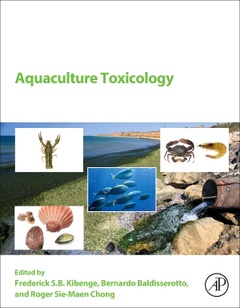Aquaculture Toxicology
Coordonnateurs : Kibenge Frederick S.B., Baldisserotto Bernardo, Chong Roger Sie-Maen

2. General Introduction Toxicology of Aquatic Animals
3. Disinfectants and Antifoulants
4. Metals
5. Agrochemicals
6. Pharmaceutical Pollutants
7. Oil and Derivatives
8. Microplastics
This book appears to be one among a series of proposed books and would be entitled “Aquaculture Toxicology. The audience for this book is stated to be “researchers, teachers, students, diagnostic laboratory staff, clinical veterinarians, aquaculture disease practitioners, biologists, farmers, and all those in industry, government or academia interested in aquaculture, fisheries and comparative biology. In my opinion and based upon the Table of Contents provided, the audience would be mainly researchers interested in toxicity of various agents to fish, crustaceans, and molluscs. Of those listed, the most likely audience for this book would be researchers, clinical veterinarians, and possibly government personnel interested in aquaculture and how treatments may affect the animals directly.
Bernardo Baldisserotto is a full professor in the Department of Physiology and Pharmacology at the Federal University of Santa Maria. He has published five books on fish physiology and fish culture, and has organized and participated in numerous other books and journal publications. Dr. Baldisserotto is editor-in-chief for the Physiology and Biochemistry section of Neotropical Ichthyology and associate editor of Fishes and the Journal of the World Aquaculture Society.
Dr. Roger Sie-Maen CHONG is a veterinary specialist in Australia and the United Kingdom (UK), with expertise in fish and shellfish pathology as applied to the health and biosecurity of aquacultured species. He is officially registered as a specialist by the Queensland Board of Veterinary Surgeons for Veterinary Aquatic Animal Health (Australia) and by the Royal College of Veterinary Surgeons for Fish Health and Production (UK). He is also a certified Fish Pathologist recognized by the Fish Health Section of the American Fisheries Society. Dr. Chong has worked in Hong Kong with the Department of Agriculture, Fisheries & Conservation, in Queensland with the Biosecurity Queensland and is presently a research fish pathologist with the Australian Commonwealth Scientific and Industrial Research Organization (CSIRO).
- Presents clinical information for the three major aquatic food animals (fish, crustaceans and mollusks)
- Discusses commonly used chemicals in aquaculture and their effects on aquatic animals and the environment
- Provides the latest advancements in the field of toxicity to facilitate fisheries and aquaculture research
Date de parution : 11-2020
Ouvrage de 248 p.
15x22.8 cm



